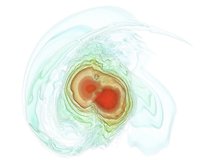Announcing the dawn of a new era of multi-messenger astrophysics, the gravitational wave event GW170817 – involving the collision of two neutron stars – was detected in 2017. In addition to the gravitational wave signal, it was accompanied by electromagnetic counterparts providing new windows into the different physics probed by the system. Since then, several gravitational wave events involving neutron stars have been discovered, with more expected over the next years.
In order to understand and interpret the physics of these events, it is necessary to model the intricate dynamics of such systems before, during and after merger, including the amplification of strong magnetic fields and the formation of hot and dense nuclear matter. Linking these multi-scale multi-physics dynamics to all observable channels (gravitational and electromagnetic) poses one of the main challenges of modern computational relativistic astrophysics and numerical relativity.
In this talk, I will discuss the state-of-the art numerical modeling of neutron star coalescence, including recent advances on the inclusion of advanced relativistic plasma and nuclear astrophysics in simulations.


